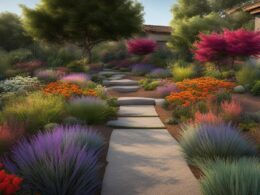Are you looking to create a beautiful and environmentally friendly garden? Xeriscape designs with native species could be the perfect solution for you. With their low-water-use and drought-tolerant qualities, these designs allow you to enjoy a vibrant landscape while conserving water. Whether you live in an arid, high-elevation, or desert climate, xeriscape gardening can transform your yard into a water-wise oasis.
Key Takeaways:
- Xeriscape designs use low-water-use or drought-tolerant plants.
- They are particularly beneficial for arid, high-elevation, and desert climates.
- Xeric plants have natural water-storing capabilities, reducing the need for excessive watering.
- Regular watering is still required during the first year or two to establish their root system.
- There is a wide variety of xeric plant options available, including perennials, herbs, shrubs, and trees.
Fantastic Xeric Plant Options for Your Garden
When it comes to designing a Xeriscape garden, the choice of plants is crucial. By selecting the right Xeric plants, you can create a beautiful and low-maintenance garden that thrives in dry conditions. Here are some fantastic options to consider:
Xeric Perennials:
Xeric perennials are a great choice for adding vibrant color and lush greenery to your garden. They require minimal maintenance and can withstand dry spells without sacrificing their beauty. Some popular Xeric perennials include Agastache Hyssop, Artemisia, Coneflower, Hosta, and Ornamental Grasses.
Mediterranean Herbs:
If you’re looking to add fragrance and flavor to your garden, Mediterranean herbs are the way to go. These herbs thrive in arid climates and require little water. Lavender, Rosemary, Santolina, Curry plant, and Thyme are all excellent choices for creating a scented and tasty Xeric garden.
Drought-Tolerant Shrubs:
For structure and texture in your garden, consider incorporating drought-tolerant shrubs. These resilient plants can withstand harsh drought conditions while adding beauty and interest to your landscape. Some popular options include Abelia, Barberry, Butterfly Bush, and Red Flowering Currant.
Low-Water Usage Trees:
If you’re looking to add shade and height to your garden while conserving water, low-water usage trees are the perfect choice. Trees like Oak, Olive, Pomegranate, and Quaking Aspen provide beauty, shade, and habitat for wildlife while minimizing water consumption.
By selecting a combination of these fantastic Xeric plant options, you can create a thriving, water-wise garden that is both visually appealing and environmentally friendly.
Xeriscaping Basics: Creating a Sustainable Garden
To create a sustainable garden through xeriscaping, there are several key factors to consider. By implementing these practices, you can conserve water, improve soil quality, and reduce maintenance requirements, all while creating a beautiful and sustainable outdoor space.
Know Your Hardiness Zone and Sun Exposure
Prior to starting your xeriscape garden, it’s important to understand your hardiness zone and the amount of sunlight your location receives. This information will help you select native plant species that are well-suited to your climate and light conditions. By choosing plants that are adapted to your area, you’ll minimize water requirements and maximize their chances of thriving.
Improve Soil Quality
Before planting, prepare your soil for success. Enhance its water-holding capacity and promote root growth by adding compost, organic matter, peat, and aged manure. These amendments will increase the soil’s ability to retain moisture, reducing the need for frequent watering. Aim to create a loose and well-draining soil environment that supports healthy plant growth.
Design for Water Conservation
Incorporate water conservation techniques into your xeriscape garden design. Reduce the amount of turfgrass areas and strategically position shade structures to provide relief to plants in full sun. Consider installing underground irrigation or utilizing drip irrigation systems to deliver water directly to the plant’s roots while minimizing evaporation. Mulching your garden beds with organic materials, such as wood chips or straw, can also help retain moisture and suppress weed growth.
| Water Conservation Tips: | Benefits: |
|---|---|
| Choose native plants adapted to your climate | Require minimal watering and are more likely to thrive |
| Utilize drip irrigation systems | Delivers water directly to plant roots, minimizing wastage |
| Mulch garden beds | Retains moisture, reduces weed growth, and regulates soil temperature |
| Limit turfgrass areas | Reduces water consumption and maintenance requirements |
Maintaining your xeriscape garden involves regular weeding, pruning, and avoiding excessive fertilization. By implementing these xeriscaping basics, you can create a sustainable garden that conserves water, supports local biodiversity, and requires less maintenance, all while enhancing the beauty of your outdoor space.
The Benefits of Xeriscape Gardening
Xeriscape gardening is a sustainable and environmentally friendly approach that offers numerous benefits. By incorporating xeric plants and following water conservation principles, you can create a beautiful garden while minimizing your environmental impact.
Water Conservation
One of the primary advantages of xeriscape gardening is its significant water-saving potential. Xeric plants are adapted to thrive in arid conditions, requiring less water compared to traditional garden plants. This translates into reduced water usage, lower water bills, and a decreased strain on local water resources.
To optimize water conservation, xeriscape gardens often utilize efficient irrigation techniques such as drip irrigation, which delivers water directly to plant roots, minimizing evaporation. Additionally, the use of mulch helps retain moisture in the soil, reducing the need for frequent watering. Overall, xeriscape gardening allows you to create a stunning landscape while responsibly managing water resources.
Biodiversity and Wildlife Support
Xeriscape gardens play a crucial role in supporting biodiversity and providing habitats for wildlife. By incorporating native plants into your garden, you attract a variety of pollinators, including bees, butterflies, and birds, promoting a healthier ecosystem. These native species have evolved alongside local wildlife, providing essential resources such as food and shelter.
Furthermore, xeriscape gardens that utilize native ground covers help prevent weed growth, reducing the need for chemical weed control. This not only benefits the environment but also minimizes water loss through evaporation. By fostering biodiversity and minimizing chemical inputs, xeriscape gardening supports a thriving ecosystem and contributes to the overall health of the environment.
Climate Change Mitigation
Xeriscape gardening also contributes to climate change mitigation efforts. Native plants in xeriscape gardens act as carbon sinks, absorbing and storing carbon dioxide from the atmosphere. This helps reduce greenhouse gas emissions and combat climate change.
Additionally, xeriscape gardens require less maintenance, reducing the use of gasoline-powered equipment such as lawnmowers, trimmers, and leaf blowers. By minimizing the use of these machines, which contribute to air pollution and carbon emissions, xeriscape gardening helps create a cleaner and more sustainable environment.
In summary, xeriscape gardening offers numerous benefits, including water conservation, support for biodiversity and wildlife, and climate change mitigation. By embracing this sustainable approach, you can create a beautiful garden while making a positive impact on the environment. Start your xeriscape garden today and contribute to a greener and more sustainable future.
What Native Species Should I Use in My Xeriscape Garden Design?
When designing a xeriscape garden, it’s important to choose native species that are well-adapted to the local climate and soil conditions. Consider using plants like yucca, agave, and penstemon, which require minimal water and maintenance. These native species will thrive in your xeriscape garden and support local biodiversity.
Conclusion
Xeriscape gardening with native plants is a sustainable and environmentally friendly way to create a beautiful and water-wise garden. By following the principles of Xeriscaping and choosing native plants, you can conserve water, support biodiversity, and reduce environmental impact.
With less water consumption, reduced maintenance, and increased property value, Xeriscape gardens are a smart choice for eco-conscious gardeners. Start your Xeriscape garden today and contribute to a greener and more sustainable future.










